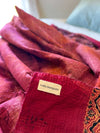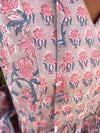
In the vast plains of Gujarat, where time seems to slow down to the rhythm of the seasons, an ancient weaving technique still lives on through the skilled hands of artisans: Tangaliya. This craft, over 700 years old and practiced by the Dangasia community (only 15 families of artisans remain), is much more than a simple textile-making process: it is a language, a symphony of threads and colors that tells the story of generations of artisans and their devotion to the art of weaving.
Tangaliya is distinguished by its unique and meticulous style, characterized by the insertion of tiny embroidery stitches, called "dang," directly into the weave of the fabric. These stitches, made by hand during the weaving process, create complex geometric patterns, evoking the purity of lines, the symmetry of forms, and the elegant simplicity of Indian tradition. These patterns appear to float on the surface of the fabric, lending a visual and tactile texture that is the hallmark of this weave.
The weavers of Gujarat do more than simply weave fabrics; they create works of art. Tangaliya is a living weaving technique, where each stitch seems to pulse to the rhythm of the hands that shape it. It demands extreme precision and perfect mastery of the loom, and each motif is the result of hours of patient work, passed down from generation to generation. Each creation is an ode to patience, creativity, and authenticity. Each stitch, each motif, tells a life story.
Tangaliya art is also distinguished by the use of natural fibers (wool and organic cotton), often dyed with natural dyes. This approach, respectful of both the environment and tradition, reinforces the authenticity and durability of each piece.
Long overlooked outside its region of origin, and even sometimes neglected within modern India, Tangaliya weaving nearly disappeared completely in the 20th century. Thanks to a handful of artisans who fought to have it recognized, it is now a protected geographical indication, and this art is gradually gaining the recognition it deserves. Fabrics woven using this technique are not only beautiful but also durable, lightweight, and comfortable to wear. The stitch patterns, often used to embellish shawls and saris, add a touch of understated elegance while remaining true to the simplicity and original purpose of these garments in the daily lives of rural communities.




0 comments